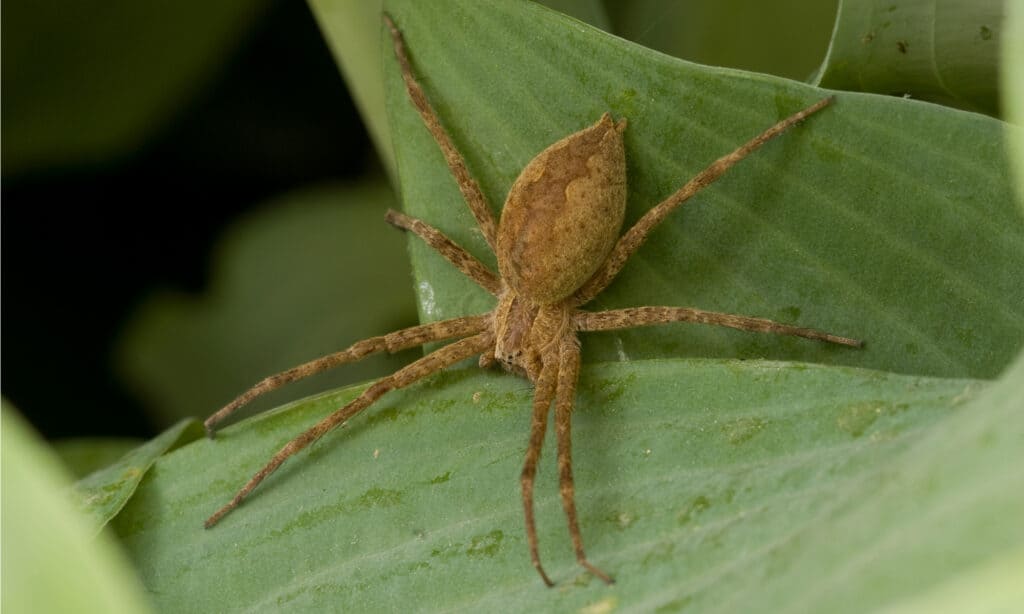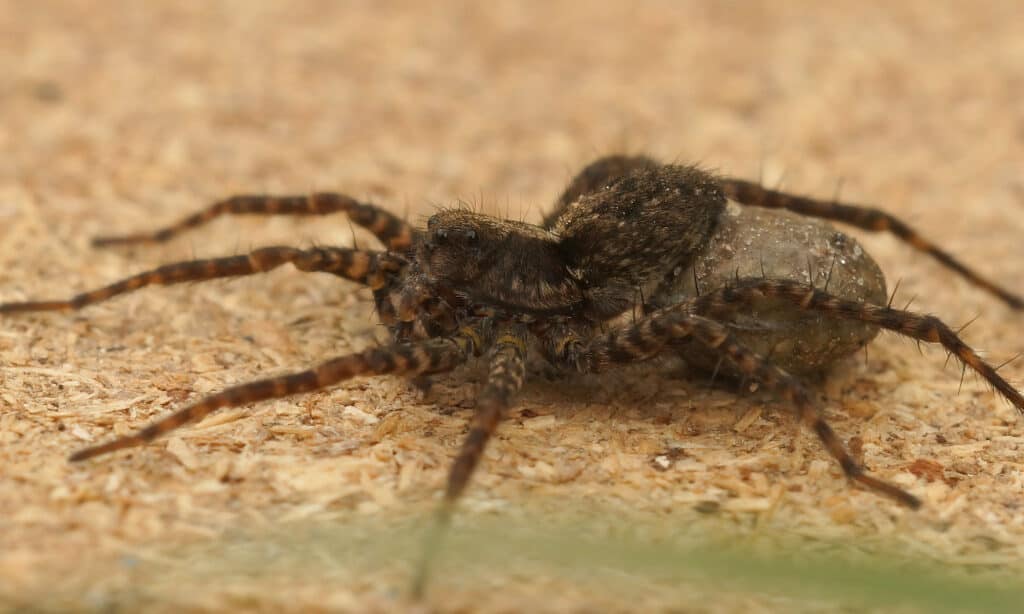Brown spiders are a common sight in many parts of the world, including in New York. These fascinating creatures have long been the subject of myth and folklore, inspiring fear and awe in people. With their intricate webs, stealthy movements, and distinctive coloring, brown spiders are truly one of nature’s most captivating critters.
Let’s delve into the world of these fascinating creatures and discover what makes them so unique and intriguing.
American Nursery Web Spider (Pisaurina mira)

©SDeming/Shutterstock.com
The American nursery web spider, scientifically named Pisaurina mira, is a type of arachnid that belongs to the Pisauridae family. It is frequently misidentified as a wolf spider and can be seen wandering in its natural habitat in New York.
Appearance
Both male and females exhibit a yellowish-brown hue and may feature a brown band down the center of their back, ranging from light to dark in color. They boast a distinct white border around the edge of their abdomen.
Males typically measure 9 to 15 mm in length, while females tend to be slightly larger, reaching 12 to 15 mm in length.
Behavior
The American nursery web spider displays remarkable behavior when faced with a predator. In such a scenario, the spider will instantly flee, making a spectacular escape. It is common for this spider to run straight toward a nearby pond or lake. If continually pursued, they have been known to run across the water’s surface and even dive underwater to escape.
Habitat
Pisaurina mira can be found in various habitats, including bushes, meadows, tall grass, woods, shrubs, and fields. They are known to have a fondness for tropical regions and may also take up residence in houses.
Eating Habits
The nursery web spider is an active hunter and does not rely on a stationary web to catch its prey. Instead, it roams through vegetation, searching for small insects to consume. These spiders are capable of capturing insects larger than themselves and even tadpoles!
Venom
While this spider possesses venom strong enough to take down its prey, including small fish, it is not a threat to humans or pets. These spiders are generally harmless and rarely attempt to bite.
Fun Facts
- The lifespan of American nursery web spiders is approximately two years.
- Pisaura mira is one of the most widespread spiders in eastern North America.
- They have a jumping ability of 5-6 inches!
Common House Spider (Parasteatoda tepidariorum)

©Sample Stars/Shutterstock.com
New York is home to many spiders that live close to humans, and the Theridiidae family’s common house spider is the most prevalent among them.
Appearance
The common house spider is characterized by its distinctive shade of brown. Additionally, it may feature brown or white spots on its abdomen. Dark rings around the legs are a particularly recognizable feature. Males have a distinct orange tint to their legs and females sport a yellowish hue.
These spiders are small, with a body length that does not exceed a quarter of an inch. Females are generally larger compared to their male counterparts.
Behavior
The common house spider is known for its quick movements. They are not aggressive by nature and usually retreat if they feel threatened. However, if they are cornered with no escape route, they may bite as a last resort. But such cases of bites from these spiders are very rare.
These spiders build webs to catch their prey, but if the web does not yield any results, they will abandon it and build a new one at a different site.
Habitat
The common house spider is highly adaptable and can thrive in various environments. They can be found in a wide range of human-made structures, including sheds, attics, basements, barns, and gardens.
Eating Habits
This spider is a carnivore and feeds on household insects, including ants, cockroaches, mosquitoes, earwigs, moths, fleas, and flies. Diet can vary depending on the species, but in general, they are opportunistic feeders that prey on any insects they can catch.
Venom
The common house spider is not harmful to humans and poses no real threat. Despite possessing venom glands, the toxin produced by these spiders isn’t strong enough to harm people.
Fun Facts
- Some of these spiders eat four times a day.
- 10 types of spiders fall into the category of common house spiders.
- Common house spiders can only see up to 3-4 inches in front of them despite having eight eyes.
Striped Fishing Spider (Dolomedes scriptus)

©Oleg Nikonov/Shutterstock.com
The striped fishing spider is part of the Pisauridae family and is known for its large size. Its natural habitat spans various regions of the United States and Canada.
Appearance
This spider is characterized by a pale brown color and light stripes on its legs and sides. Males have a noticeable white band on their bodies, while females are identified by the dark band around their cephalothorax.
Females have a leg span of more than 5.9 inches, making them slightly larger than the males.
Behavior
It is known for its unique hunting behavior, which involves sensing vibrations on the water surface to locate its prey. This spider then skates across the surface to capture and subdue their prey. Like many other fishing spiders, this species can go underwater to hunt smaller aquatic animals such as fish.
Habitat
The natural habitat of the striped fishing spider is near bodies of water, with a preference for streams, especially fast-flowing ones. They can be found along the water’s edge, resting with their front legs stretched out on the surface.
Eating Habits
This fishing spider’s diet consists of both aquatic and nonaquatic insects, as well as other prey such as small fish. They are incredibly versatile hunters, and they can capture and subdue a wide range of prey.
Venom
The striped fishing spider can bite and release venom, but its venom is not known to be harmful to humans. However, some individuals have a specific allergy to this venom and may experience issues if bitten.
Fun Facts
- There are around 100 species of fishing spiders found all over the world.
- Fishing spiders, including striped fishing spiders, prefer a solitary lifestyle, like other spider species.
- These spiders have a life span of one to two years, with females having a longer lifespan on average than males.
Wetland Giant Wolf Spider (Tigrosa helluo)

©HWall/Shutterstock.com
In New York, you might come across the fearsome Tigrosa helluo, a member of the Lycosidae family that was once referred to as Hogna helluo.
Appearance
The wetland giant wolf spider has a recognizable brown body with a striking yellow stripe that starts from its front eyes and runs down the cephalothorax. The black spots on the bottom of the abdomen further distinguish it from other wolf spiders.
Its size varies from half an inch to over 2 inches, making it a potentially intimidating presence.
Behavior
Wetland giant wolf spiders, like other members of the Lycosidae family, are solitary creatures who live and hunt independently. They do not socialize unless they are mating. Typically, they are most active at nighttime when they are in search of food.
Habitat
These spiders inhabit various areas, including open fields, swamps, forests, and areas near rivers. They have a preference for wet environments over dry ones, as evidenced by their name!
Eating Habits
The diet of wetland giant wolf spiders primarily includes beetles, crickets, cockroaches, fly larvae, mealworms, and other insects. As nocturnal hunters, they search for prey at night and use their keen skills to capture their food.
Venom
Wolf spiders are generally not a threat to humans. Although it’s possible to have an allergic reaction to their venom, this is rare, and they are not classified as poisonous. Due to their size, their bite can be uncomfortable but should only cause temporary mild discomfort, such as pain, swelling, or itching.
Fun Facts
- Wetland giant wolf spiders are known for their speed.
- Wolf spiders are so named because they hunt their prey like wolves!
- Uniquely, wolf spiders are the only spider species that carry their young on their backs.
Bronze Jumper Spider (Eris militaris)

©iStock.com/Andrew Waugh
The Eris militaris, known by its common names of bronze jumper or bronze lake jumper, is a fascinating arachnid that calls New York its home. This charismatic spider, hailing from the Salticidae family, is notorious for its remarkable jumping abilities.
Appearance
The bronze jumper spider has a brown abdomen adorned with several small, light-colored spots. Females typically having four pairs of well-defined spots. Its legs are short, facing forward, and made for jumping. The first segment (coxa) of each leg is light-yellow.
Females can grow to be 0.24 to 0.31 inches in length, while males are typically smaller at around 0.18 to 0.26 inches long.
Behavior
Bronze jumper spiders shy away from cold weather. In the autumn season, they tend to seek refuge in homes to escape the harsh winter elements. They are most active during the springtime when temperatures rise, and they are often seen lurking around windowsills, hunting for flies and other small insects.
Habitat
The Eris militaris is a tiny but well-known species of jumping spider, found in both urban and rural areas, including woods, fields, and homes. However, due to its small size, people frequently overlook it.
Eating Habits
The diet of bronze jumper spiders mainly consists of small insects such as grasshoppers, flies, moths, and other spiders. They have a versatile appetite and will consume any insect they can get their chelicerae (jaws) around.
Venom
Like many other species, these spiders possess fangs and produce venom, but their bite is not harmful to humans. While in some instances, they may bite in defense, these spiders are generally more likely to flee from humans.
Fun Facts
- Bronze jumper spiders are skilled hunters, using their exceptional jumping ability to capture prey.
- No species of jumping spider in America pose a medical threat to humans.
- Despite not having special leg muscles, like those found in grasshoppers, jumping spiders can still leap quite well.
Up Next
- Yellow Spiders: Joro Spider vs Garden Spider vs Banana Spider
- Spider Predators: What Eats Spiders?
- Rabid Wolf Spider vs Wolf Spider
The post Discover 5 Brown Spiders in New York appeared first on AZ Animals.
from Animal News, Facts, Rankings, and More! - AZ Animals https://ift.tt/6d3HPMW